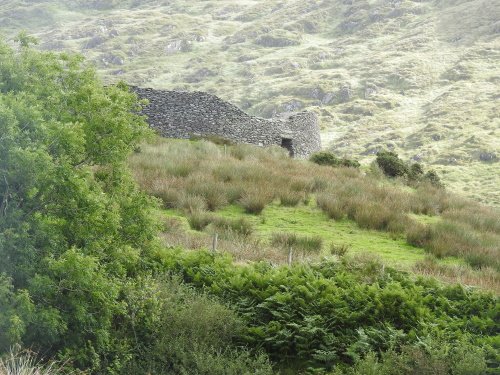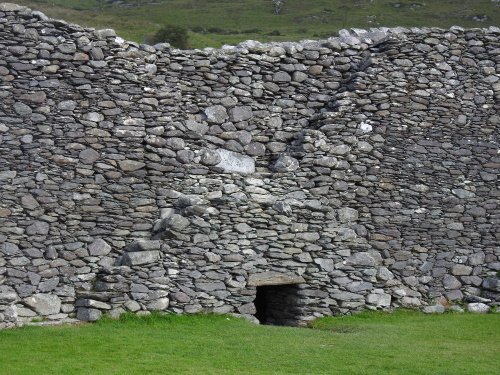Staigue Fort is one of five early medieval drystone enclosures that make up the
Western Stone Forts
, a site on the Irish Tentative List. It is located along the touristic route known as the Ring of Kerry, a few kilometers off the main road at the end of a narrow way. I visited it on my way back to Cork Airport after an unsuccessful hit at
Skellig Michael
(BTW - I did
see the island so well
from the Kerry Cliffs that I was tempted to count it as a ‘visit’! If it had been inscribed on natural criteria as well, I would have).

Back to Staigue Fort: it lies in a lovely location, against a hill and due to its massive size (up to 5.5m high and 27m in diameter) it can be seen from afar. There were two other cars at the parking lot when I arrived, plus a shepherd and his two dogs. At the entrance gate they want you to put a 1 EUR coin into a moneybox as a “Land Trespass charge”, though there’s no one to enforce it. The trespassing sign may indicate that this land is in private ownership, which limits its chances of ever getting inscribed as a WHS.
The dates and function of these Western Stone Forts are all very unclear. Wikpedia has it that the one at Staigue was built somewhere between 300 and 400 AD, as a defensive stronghold for a local lord or king. The sign at the site itself says “in the early centuries AD” and the “home of a very wealthy landowner or chieftain who had great need for security”. The description at the UNESCO website mentions a period of 700-1000 AD for all and them being “the principal residences of the kings or sub-kings of various Early Medieval dynastic groups”.

Well, whatever. It is a fine piece of drystone construction. What remains is only the outer wall – the people would have lived in huts inside the perimeter. Somehow it reminded me of the
Fujian Tulou
. It’s a mystery why there are so many stairways on the interior to get to the top of the wall. Was it to defend it from invaders coming from all angles?
Three of the other Stone Forts stay unreviewed on this website til this day. I only just added their approximate locations to the map. The ones for Benagh and Cahercommaun are unsure to say the least. Caherconree Promontory Fortress on the other hand may be worth checking out in the future by someone stuck at Portmagee waiting for a boat to Skellig Michael. There is a 2 hour return hike towards it on the way to the summit of the Caherconree. Details on the trail can be found
here
.

So what will come out of the Irish Tentative List in general? In January the Irish Minister for Culture
has called for applications
to a new Tentative List, which should cover the years 2020-2030. From the current list the one likely to remain is the
Royal Sites
– they are slowly making progress, but component parts in private hands and one possible location in Northern Ireland makes it difficult going. Regarding the Western Stone Forts, the 7 stone forts on the Aran Islands (although it’s unclear which ones would make up the 7 in total) may be a better choice in general than the scattered bunch which are now part of the selection.
One of the likely new additions is Valentia Telegraph Station, a transnational site with Canada’s
Heart’s Content Cable Station
. This is also an easy visit while you’re waiting for Skellig Michael boats to leave: Valentia is just across the bridge from Portmagee. There are
2 small monuments
on the shore at the spot where the telegraph cable began. Also the original Cable Station
has recently been handed over
from private hands to the local community, probably to be turned into a museum / interpretative center. Not too far away, Cork seems to
have plans for its harbor
as well to become a site on the new Tentative List.



